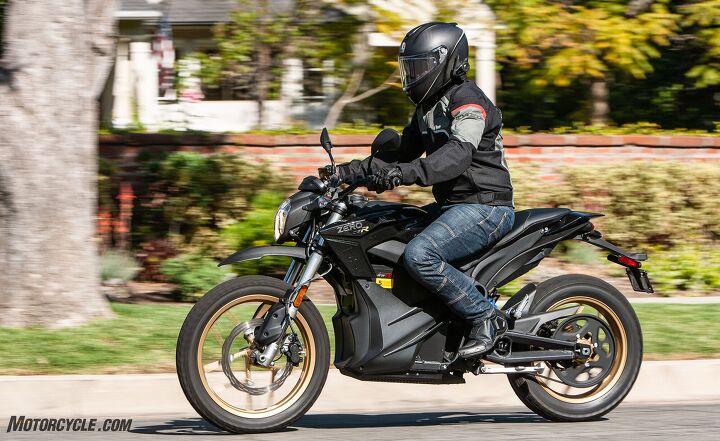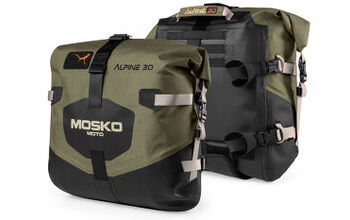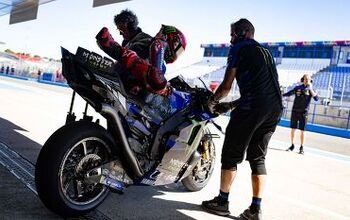Urban Electric Motorcycles: BMW C Evolution Scooter And Zero DSR

The correct tool is determined by what you need to do with it
Once upon a time, electric motorcycles had such short range and high MSRPs that only the most devoted of early adopters had a reason to consider owning one. Well, in the past couple years, improvements in range have resulted in electrics now being a viable option for riders who are looking for a greener alternative to internal combustion engine (ICE) motorcycles, which are relatively dirty compared to four-wheeled road users. So, we’ve taken the 2018 BMW C Evolution scooter and the 2018 Zero DSR as representatives of two different approaches to urban electric motorcycles to see how they stack up for everyday use. Note: This is not our typical comparison where we try to determine the best motorcycle out of a pairing. Rather, we are looking at two different electric bikes to determine their viability as urban transport.
Get the Flash Player to see this player.
While the price of electrics is still comparatively high compared to fossil fuel-powered motorcycles, the range electrics are capable of achieving has improved to the point that they are viable for urban use, particularly as commuter vehicles. The 2009 US Census lists the average commuter time as being 25.1 minutes, which would translate – even at a sustained 70mph – at well below the range of the two electric motorcycles featured in this comparison. Even if we looked at what the Washington Post listed as “long distance commutes,” which are a more than 50 mile route each way to work, we’re still in the range of our two competitors. Calculate in charging time while at work, and the range of an electric as a commuter option gets extended even further than just the round trip from home.
So, how do the C Evolution and the DSR compare in the urban jungle? Read on and find out.
Commuter duty
Since all of the MO staff work from their homes, making our daily commutes walking distance – no travel mug required – we had to replicate what it would be like commuting on these two bikes. Around LA County, that’s easy, just get on the freeway at any time during business hours, and you’ll encounter traffic that mimics rush hour in many other cities. The same is true of the surface streets around city centers.
Both bikes feature the quick off-the-line acceleration that characterizes electric vehicles. Having maximum torque available as soon as you twist the throttle is a boon for putting the cagers behind you. When compared to ICE scooters, the BMW gets a head start at stoplights, squirting away from all but the most assertive car drivers. However, at a claimed 49 lb-ft of torque, the C Evolution has less than half the instantaneous twisting force available as the DSR. So, the Zero can dust any comers in the stoplight grand prix.
Here’s what Ryan Adams had to say: “For me, one of the fun things about electric bikes is the opportunity of near instantaneous torque. Both the BMW and the Zero offer enough acceleration to blow the doors off of the odd family sedan around town, but the DSR brings more than two times the torque of the C-Evolution to the line: 116 lb-ft of torque (claimed) ain’t no joke.”
Moving up the entrance ramp to the freeway, both the BMW and the Zero have the chops to accelerate up to the speed of the traffic flow with authority. While the C Evolution is limited to 80 mph, it comfortably mixes with the rest of the fray. The Beemer’s 15-inch wheels never feel twitchy at highway speeds, but they don’t feel as stable as the Zero’s 19/17-inch pairing. The Zero’s triple-digit top speed means that it is more than capable of holding its own on highways like those around Los Angeles where traffic, when moving, can exceed 80 mph. However, those higher speeds really suck the battery power.
When it comes to lane sharing, the BMW, with it’s amazingly balanced chassis (the bulk of the claimed 606 lb weight is carried low in the frame) is able to crawl between cars when things get narrow – something that happens frequently because its mirrors are the same height as many car mirrors. The DSR, with its upright riding position and high bars/mirrors, needs less space.
In city traffic, the BMW’s nimbleness is much appreciated when it comes time to dodge potholes or other road debris. The DSR is no slouch when it comes to maneuverability, but in this case, the C Evolution is just slightly better.
Those everyday errands
Not all urban motorcycles are used solely for commuter duty. Frequently, they are used for short-hop chores, like grocery shopping. While the BMW sacrificed about half of its under seat storage to the battery pack, it still has enough to buy food for dinner for two but little more. However, the practicality of a storage compartment can’t be overstated. For the couple of weeks I had both the BMW and the Zero in my garage, I found myself running more errands on the Beemer. It was just too convenient. If I went shopping, I could store my helmet under the seat and not have to carry it while off the bike.
Once Ryan stole the DSR from me, he didn’t let its lack of storage stop him from running around town on it: “In terms of practicality, it would be easy to say the BMW gets the nod for having a trunk, but running errands on the Zero didn’t stop me from picking up a dirtbike stand, strapping it to the back, and slicing my way home through traffic stealthily.”
When riding around town, one becomes aware of how high the BMW’s seat feels for a scooter. You know it’s odd when a bike with a seat height listed as 33.2 inches doesn’t feel as tall as one that’s supposed to be three inches shorter. “Don’t be fooled by the spec sheet stating the seat height is 30.1 in.,” notes Ryan, “the girth of the C-Evo contributes to the seat feeling much taller than it is.”
Avoiding anxiety
Range anxiety is a catchy term to describe the limitations in how far electric motorcycles can travel, but both of our contestants came with Level 2 chargers built-in. Although the BMW’s 220V charging system is a standard item, the Zero’s is a $2,295 option that both Ryan and I feel is absolutely necessary for an EV. Many shopping malls and parking structures are adding charging stations at a fairly rapid rate. This means you can top off – or at least partially fill – your battery while you enjoy a cup of coffee or see a movie. Being able to add to your range when you stop goes a long way towards reducing range anxiety.
Opines Ryan: “The fact the the BMW C-Evolution comes standard with level-2 charging as well as a 110 V adapter seems like it should be commonplace for electrics, but that simply isn’t the case. On the Zero DSR, you have to pay $2,295 for the option to charge at a level two station. That makes the BMW’s MSRP of $13,750 look like a bargain next to Zero’s $16,495 (+2,295 Charge Tank).”
Despite the frequent critiques from the gasoline-addled peanut gallery, we think that electric motorcycles have finally reached the tipping point, particularly in around town use. The BMW is capable of a claimed 99 miles, while the DSR is claimed to go about 20% further. This is far enough for your typical everyday motorcycle use. Still, we acknowledge that most people won’t want to tour on an electric bike – though some people have ridden them across the continent.
Escaping the jungle
Both the C Evo and the DSR are capable of short jaunts up winding roads, and they are a blast to ride. However, the differences between a scooter and a motorcycle are the primary defining characteristics of a canyon ride. The BMW’s lightning-fast turn in makes it a blast on a really tight, technical road, whereas the Zero, with its 19-inch front wheel, takes a little more effort to snap into a turn. However, those bigger wheels translate into more stability at velocities that leave the speed-limited C Evolution behind.
Suspension is another place where the Zero outshines the BMW – both in and out of the city. Potholes are swallowed by the DSR’s 7 inches of travel. It simply has more to work with when handling even smaller road imperfections. So, the BMW’s ride comes off as sportily stiff until it gets overwhelmed. Then it just feels harsh. The Zero is both plush and sporty.
Ryan defined their canyon capabilities thusly: “The Zero’s Showa suspension components are tuned really nicely for the duty it’s meant to handle, soft enough to take small hits on the trail or torn up asphalt, yet never feeling wallowy. The C-Evolution is set up fairly sporty which is kind of fun. Strong brakes, firm suspension, and rapid acceleration mean you can have your commuter cake and and enjoy it too.”
Ryan’s comment alluded to one characteristic where the bikes absolutely diverge, off-road riding. The Zero DSR has the suspension and the tires for light-duty – read fire road – dirt riding. I’ll defer to Ryan’s expertise and let him take it from here: “Riding the Zero off-road (mainly huge gravel lots so I could play) is so good. The gobs of torque allow you to break the rear tire loose with a slight blip of a throttle. Drifting power slides are addicting and being able to spin up the rear MT 60 in a straight line at any moment by goosing the throttle lets you know you’re on a serious machine.” Just don’t get carried away and try jumping the DSR, as that could create issues with the belt. But big, crossed-up slides? Have at it!
Etcetera
Both of these bikes offer features that don’t fit neatly into any category. First, the BMW’s Reverse Assist saves a lot of effort. “The C Evolution is too tall and heavy to push backward on your own,” notes Ryan. “I never noticed the 606-pounds of heft on the BMW until I tried pushing it backward out of a parking space. Thankfully, it has Reverse Assist, and I was pleasantly rocketing at full throttle backwards in no time. Easy with the wrist when reversing. It can get dicey.”
Then there is my favorite feature – once I figured it out – of the C Evo. Where ICE motorcycles consistent engine braking, the BMW, when set in Dynamic mode, allows the rider to control the amount of deceleration generated by the regeneration with the throttle.
Here’s what I said in my review of the C Evolution: “Essentially, I controlled braking that the regeneration applied with my throttle-hand without touching the brakes themselves. If I needed to slow down slightly for a corner, I just dipped out of the neutral throttle zone. A tighter corner received a more aggressive roll-out of the throttle. I had so much fun doing this that I ended up trying it on the Interstate to similar results.”
The Zero also has tunable regenerative “engine braking,” only you use a smartphone app to dial in the amount you want when you roll off the throttle. Not just the regeneration is tunable via the app. Almost every other facet of the engine has a slider to fiddle with.
Reaching a conclusion
As noted at the beginning of this comparison, we’re not here to tell you which of these machines is the better motorcycle. Rather, this is an overview of two different approaches to urban electric motorcycles. In the end, which of these is the right bike for you depends on what you plan on doing with the bike.
If you plan on running errands around town – or school, for that matter – the electric scooter lifestyle may suit you better, and the BMW C Evolution won’t let you down in this regard. For those who have commutes consisting of largely surface streets rather than highways, I would still give a serious look at the BMW – particularly since it comes with the Level 2 charger as a standard feature.
However, while the BMW does just fine on the freeway, I think I’d be inclined to select the Zero as my highway commuter mount. It has longer range, but more importantly, it feels more like a full-sized motorcycle. The rider is more upright and had a clearer view of the road ahead. Let’s also not forget the option of mild off-road riding, too.
Neither of these urban electrics are cheap. The BMW weighs in with a $13,750 price tag, while the Zero starts $2,745 higher. If you want a Level 2 charger on the Zero, add an additional $2,295 for a total of $18,790. So, the prices still put the bikes in a relatively niche market. Still, you get a lot more for your money than you did a few years ago.
Here at MO, we’re pretty excited by what has been happening in the electric market, and power, range, and price will only get better as the technology progresses. The future is occurring now, and we’re excited to be here witnessing it.
In Gear

Helmet: AGV Sportmodular Tricolore $849.95
- Jacket: Alpinestars Hyper Drystar Jacket $269.95
- Gloves: REV’IT! Sand 3 Gloves $109.99
- Pants: Alpinestars Crank Denim Pants $249.95
- Boots: Dainese R Axial Pro $519.95
Pack: Kriega R25 Backpack $189.00

Urban Electrics Comparo | ||
|---|---|---|
2018 BMW C Evolution | 2018 Zero DSR | |
| MSRP | $13,750 | $16,495, $18,790 with Charge Tank |
| Engine Type | Liquid-cooled electric-drive motor | Z-Force 75-7R passively air-cooled, interior permanent hi-temp magnet, brushless motor |
| Max. output | 48 hp (35 kW) at 4,650 rpm (claimed) | 70 hp at 3500 rpm (claimed) |
| Max. torque | 53 lb-ft (claimed) | 116 ft-lb (claimed) |
| Maximum speed | 80 mph (electronically limited) | Adjustable to 110 mph (claimed) |
| Range | 99 miles (claimed) | 105 miles, combined (claimed) |
| Recuperation | Automatic recuperation when coasting and braking | Regenerative deceleration |
| Battery | Air-cooled lithium-ion high-voltage battery with auxiliary cooling fan | Z-Force Li-Ion intelligent integrated |
| Battery Capacity | 12.5 kWh | 14.4 kWh (18.0 kWh with Power Tank) |
| Charging Rate | 3 kW, integrated charging unit | 1.3 kW, integrated charging unit |
| Charging Type | Type 1 | Type 1 |
| Charging time at 220 V / 12 A | approx.. 4:30 h for 100%; 80% in approx.. 3:50 h (claimed) | With Charge Tank: 2.5 hours for 100%; 95% in 2.0 hours |
| Drive | Belt drive | Belt drive |
| Front suspension | Upside-down fork Ø 40 mm, 4.7 inches of travel | Showa 41 mm inverted cartridge forks, with adjustable spring preload, compression and rebound damping, 7.0 inches of travel |
| Rear suspension | Single-sided swing arm with direct-link spring strut and spring pre-load with 7 manually adjustable settings, 4.5 inches of travel | Showa 40 mm piston, piggy-back reservoir shock with adjustable spring preload, compression and rebound damping, 7.03 inches of travel |
| Wheelbase | 63.4 inches | 56.2 inches |
| Castor | 3.7 inches | 4.6 inches |
| Rake | 24.1° | 26.5° |
| Front Wheel | 3.50 x 15 | 2.50 x 19 |
| Rear Wheel | 4.50 x 15 | 3.50 x 17 |
| Front Tire | 120/70 R 15 | Pirelli MT-60 100/90-19 |
| Rear Tire | 160/60 R 15 | Pirelli MT-60 130/80-17 |
| Brake, front | Dual floating disc brakes, dual-piston floating calipers, diameter 270 mm | J-Juan asymmetric dual piston floating caliper, 320 x 5 mm disc |
| Brake, rear | Single disc brake, diameter 270 mm, dual-piston floating caliper | J-Juan single piston floating caliper, 240 x 4.5 mm disc |
| ABS | BMW Motorrad ABS | Bosch Gen 9 ABS |
| Length | 86.2 inches | |
| Seat height, unladen weight | 30.1 inches (Standard ) 30.9 inches (Comfort seat) | 33.2 inches |
| Curb Weight | 606 pounds (claimed) | 419 pounds (claimed) |

Like most of the best happenings in his life, Evans stumbled into his motojournalism career. While on his way to a planned life in academia, he applied for a job at a motorcycle magazine, thinking he’d get the opportunity to write some freelance articles. Instead, he was offered a full-time job in which he discovered he could actually get paid to ride other people’s motorcycles – and he’s never looked back. Over the 25 years he’s been in the motorcycle industry, Evans has written two books, 101 Sportbike Performance Projects and How to Modify Your Metric Cruiser, and has ridden just about every production motorcycle manufactured. Evans has a deep love of motorcycles and believes they are a force for good in the world.
More by Evans Brasfield






















































Comments
Join the conversation
I got my first electric motorcycle in 2008 and have crossed the country several times on Zeros and ride through all the lower 48 states, Canada, and Mexico . Currently riding a 2016 Zero SR as my main form of transportation. Riding from Maine to Florida this summer has been a blast!
After 25 years on big V-engine ICE motorcycles I switched to a Zero S 2.5 years ago and I'm never coming back to ICE. Electric is simply too much fun. I enjoy every morning commute.